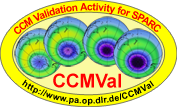 |
Possible
specifications
of external forcings From the CCM
validation activity for SPARC (CCMVal) 1st
Draft, February 2005 |
 |
Possible
specifications
of external forcings From the CCM
validation activity for SPARC (CCMVal) 1st
Draft, February 2005 |
|
|
| (A) Reproducing the past: Forcings for a transient model simulation 1960 to 2000 |
A1.
Greenhouse
Gases 1959 to 2000 (CO2, CH4,
N2O)
GHG scenarios for WMO/UNEP 2002 runs. The file gives surface volume mixing ratios of CH4 (ppbv), N2O (ppbv) and CO2 (ppmv)Data set 1959 to 2000 based on WMO (2003).
The
influence of the 11-year solar cycle on photolysis rates is
parameterised
according to the intensity of the 10.7 cm radiation of the sun (data
available
at: http://www.drao.nrc.ca/icarus/www/daily.html).
The
spectral distribution of changes in extra-terrestrial flux is based on
investigations presented by Lean et al. (1997).
Recommendation: Use observed flux
(column 3 in maver_1951-2000.dat)
10,7 cm solar flux from http://www.drao.nrc.ca/icarus/www/maver.txt
More explanation see http://www.drao.nrc.ca/icarus/www/sol_home.shtml
A5.
Assimilated
Quasi-Biennial
Oscillation (QBO)
The QBO has been assimilated in several studies with the aim to
study QBO effects on the dynamics and/or chemistry. Often the
assimilation procedures assume a certain idealistic
meridional structure of the QBO jets and force the model to follow the
externally given vertical zonal wind structure within the QBO domain.
Even simple relaxation methods (see for example Giorgetta et al., 1999)
can provide fairly realistic QBO structures, and the GCM will generate
the secondary meridional circulation of the QBO and the related
temperature signal. This can provide a significant improvement for
certain experiments. The method implies nearly no costs compared to the
costs of the GCM integration.
The QBO is described by zonal wind profiles measured at the equator.
QBO
data sets provided by Marco Giorgetta (Contact for questions: Marco Giorgetta
)
A6.
Other
issues
(a) Volcanic eruptions (Contact
for questions: Rolando
Garcia
and Doug Kinnison)
Stratospheric
aerosols. Some groups will include the impact of volcanic
eruptions on the aerosol distribution, both in the chemistry and
radiative packages.
* e.g. surface area density data set
supplied to us by Susan Solomon.
This data set is based on SAGEI, SAGE II, and SAM data (Thomason,
et al). We are also examining the WMO2002 SAD dataset put together by
David Considine, LaRC. This data set is also based on SAGE and SAM
data.
* e.g. Heating from volcanic aerosols from
the CAM approach by Bill
Collins
(b) Impact of new HCFCs (141B, 142B, 123) (Contact for questions: Rolando Garcia and Doug Kinnison)
e.g.
instead of including HCFCs explicitly, we could instead use MCF,
HCFC22 and CH3Cl as "surrogates", as follows:
MCF --> MCF + 2/3 * HCFC141B
HCFC22 --> HCFC22 + 1.0 * HCFC142B
CH3Cl --> CH3CL + 2.0 * HCFC123
This approach was used in the WMO1998 2D model assessment. These
surrogates have similar tropospheric and stratospheric lifetimes as the
omitted HCFCs.
A7.
References
WMO, 2003: Scientific
Assessment of Ozone Depletion: 2002. Global
Ozone Research and Monitoring Project, Report No. 47,
498 pp,
| (B) Making predictions: Forcings for a transient model simulation 1990 to 2050 (or to 2100) |
AGREEMENT ON SCENARIO needed. Scenarios proposed so far: IPCC scenario A1b (medium) or B2 for CH4, N2O, and CO2
AGREEMENT
ON SCENARIO needed. So far proposed: Scenario Ab
(best guess scenario), Scenario
B2 (Table 4B-2 of WMO2003, page 4.90)
UNEP/WMO Scientific
Assessment of Ozone Depletion: 2002
Chapter 1: Controlled substances and other trace gases
Scenarios from Archie McCulloch (Marbury Techn. Cons.), John Daniel
(NOAA/AL), Steve Montzka (NOAA/CMDL), and Guus Velders (RIVM/LLO),
September 21, 2001 (Version 3)
For the model
simulation, please use scenario -> ?
Download data:
Data
set (2001 to 2099) adopted from Table 1-16 WMO (2003), Scenario Ab
(best guess scenario), year by year variations
AGREEMENT ON FUTURE SSTs needed or a decision has to
be made that each group runs with model compliant SSTs
Soon on
this web site
The
QBO is described by zonal wind profiles measured at the equator.
QBO
data sets for the future are provided by Marco Giorgetta (Contact for
questions: Marco
Giorgetta
)
| Last modified: February 15, 2005 by Veronika Eyring |